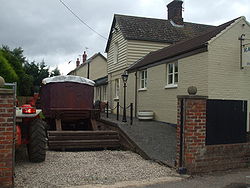
Burnham Market railway station
Encyclopedia
Burnham Market was a railway station which served the village of Burnham Market
in Norfolk
, England
. Opened by the West Norfolk Junction railway in 1866, it closed with the line in 1952.
with the seaside town of Hunstanton
. The West Norfolk opened in 1866 at the start of a major financial crisis triggered by the collapse of Overend Gurney Bank
; the year also saw the outbreak of a "cattle plague" in North Norfolk
which impacted on the cattle receipts on the line. The West Norfolk was absorbed into the Lynn and Hunstanton Railway in 1872 which in turn was acquired by the Great Eastern Railway
in 1890. The line eventually closed to passengers in 1952, a consequence of rising costs and falling passenger numbers, aggravated by the inconvenient siting of stations. Up to the end of its passenger services, the line was one of the last where one could travel in gas-lit cleristory coaches hauled by Victorian locomotives.
A freight service continued to operate until 1963, though it was cut back to Heacham/Burnham Market after the North Sea flood of 1953
which badly damaged the section between Holkham
and Wells
, damage which British Rail
judged not worth repairing.
Burnham Market was the principal intermediate station on the West Norfolk branch, serving the largest settlement between Heacham and Wells. Its importance was to decline towards the end of the nineteenth century as it shed its urban functions to become the village it is today. A single platform was provided together with a brick station building situated on the down side of the line. A crossing loop to the west of the station allowing it to be a passing place. Four sidings led from the loop to serve a goods yard equipped with a red brick goods shed. Another siding led to a nearby brickworks
which used the railway to import coal. The station, like many others along the line, also handled its fair share of agricultural traffic and, in addition, some fish traffic (notably shellfish
) from nearby villages such as Brancaster
and Burnham Overy
.
The station was also the nearest to Lord Nelson's birthplace at Burnham Thorpe
, a fact capitalised on by the Great Eastern Railway which erected large nameboards proclaiming that this was the station "For Burnham Thorpe & Nelson's Birthplace". That village could be discerned from the train as it passed over the little River Burn
within half-a-mile of Burnham Thorpe Church where Nelson's father was Rector from 1755 to 1802.
 Following closure, the station was for some time used as a garage ("Burnham Motors") with the goods shed used as a workshop; the buildings were well-looked after by the proprietor, Mr A.B. Mason. In 1996 it became a residential annexe for "The Hoste Arms" hotel, before being offered for sale for £695,000 in April 2005. When the property failed to sell, it was reported later that year that a planning application had been lodged to demolish the station buildings. The buildings were however saved and converted into a boutique hotel known as "The Railway Inn"; part of the platform has been restored and a 19th century railway carriage placed on a reinstated section of track. The owner had hoped to use the carriage as extra accommodation but this was not possible as it would require too many original fittings to be insulated.
Following closure, the station was for some time used as a garage ("Burnham Motors") with the goods shed used as a workshop; the buildings were well-looked after by the proprietor, Mr A.B. Mason. In 1996 it became a residential annexe for "The Hoste Arms" hotel, before being offered for sale for £695,000 in April 2005. When the property failed to sell, it was reported later that year that a planning application had been lodged to demolish the station buildings. The buildings were however saved and converted into a boutique hotel known as "The Railway Inn"; part of the platform has been restored and a 19th century railway carriage placed on a reinstated section of track. The owner had hoped to use the carriage as extra accommodation but this was not possible as it would require too many original fittings to be insulated.
Burnham Market
Burnham Market is a village with and civil parish near the north coast of Norfolk, England. Burnham Market is one of the Burnhams, a group of adjacent villages in North Norfolk...
in Norfolk
Norfolk
Norfolk is a low-lying county in the East of England. It has borders with Lincolnshire to the west, Cambridgeshire to the west and southwest and Suffolk to the south. Its northern and eastern boundaries are the North Sea coast and to the north-west the county is bordered by The Wash. The county...
, England
England
England is a country that is part of the United Kingdom. It shares land borders with Scotland to the north and Wales to the west; the Irish Sea is to the north west, the Celtic Sea to the south west, with the North Sea to the east and the English Channel to the south separating it from continental...
. Opened by the West Norfolk Junction railway in 1866, it closed with the line in 1952.
History
The construction of the West Norfolk Junction Railway was prompted by the success of the Lynn and Hunstanton Railway which had opened in 1862 to link King's LynnKing's Lynn railway station
King's Lynn railway station serves the town of King's Lynn in Norfolk. The station is the terminus of the Fen Line from Cambridge, which is electrified at 25 kV AC overhead...
with the seaside town of Hunstanton
Hunstanton railway station
Hunstanton was a railway station which served the seaside town of Hunstanton in Norfolk, England. Opened in 1862, the station was the northern terminus of the King's Lynn to Hunstanton line immortalised by John Betjeman in the British Transport Film John Betjeman Goes By Train...
. The West Norfolk opened in 1866 at the start of a major financial crisis triggered by the collapse of Overend Gurney Bank
Overend, Gurney and Company
Overend, Gurney & Company was a London wholesale discount bank, known as "the bankers' bank", which collapsed in 1866 owing about 11 million pounds, equivalent to £981 million at 2008 prices.-Early years:...
; the year also saw the outbreak of a "cattle plague" in North Norfolk
North Norfolk
North Norfolk is a local government district in Norfolk, United Kingdom. Its council is based in Cromer. The council headquarters can be found approximately out of the town of Cromer on the Holt Road.-History:...
which impacted on the cattle receipts on the line. The West Norfolk was absorbed into the Lynn and Hunstanton Railway in 1872 which in turn was acquired by the Great Eastern Railway
Great Eastern Railway
The Great Eastern Railway was a pre-grouping British railway company, whose main line linked London Liverpool Street to Norwich and which had other lines through East Anglia...
in 1890. The line eventually closed to passengers in 1952, a consequence of rising costs and falling passenger numbers, aggravated by the inconvenient siting of stations. Up to the end of its passenger services, the line was one of the last where one could travel in gas-lit cleristory coaches hauled by Victorian locomotives.
A freight service continued to operate until 1963, though it was cut back to Heacham/Burnham Market after the North Sea flood of 1953
North Sea flood of 1953
The 1953 North Sea flood was a major flood caused by a heavy storm, that occurred on the night of Saturday 31 January 1953 and morning of 1 February 1953. The floods struck the Netherlands, Belgium, England and Scotland.A combination of a high spring tide and a severe European windstorm caused a...
which badly damaged the section between Holkham
Holkham railway station
Holkham was a railway station which served the coastal village of Holkham in Norfolk, England. Opened by the West Norfolk Junction railway in 1866, it closed with the line in 1952.- History :...
and Wells
Wells-On-Sea railway station
Wells-next-the-Sea railway station served the small seaside port of Wells-next-the-Sea in North Norfolk, England. It was opened in 1857 by the Wells & Fakenham Railway, later part of the Great Eastern Railway's Wymondham to Wells branch, and became a junction in 1866 with the arrival of the West...
, damage which British Rail
Eastern Region of British Railways
The Eastern Region was a region of British Railways from 1948. The region ceased to be an operating unit in its own right in the 1980s and was wound up at the end of 1992...
judged not worth repairing.
Burnham Market was the principal intermediate station on the West Norfolk branch, serving the largest settlement between Heacham and Wells. Its importance was to decline towards the end of the nineteenth century as it shed its urban functions to become the village it is today. A single platform was provided together with a brick station building situated on the down side of the line. A crossing loop to the west of the station allowing it to be a passing place. Four sidings led from the loop to serve a goods yard equipped with a red brick goods shed. Another siding led to a nearby brickworks
Brickworks
A brickworks also known as a brick factory, is a factory for the manufacturing of bricks, from clay or shale. Usually a brickworks is located on a clay bedrock often with a quarry for clay on site....
which used the railway to import coal. The station, like many others along the line, also handled its fair share of agricultural traffic and, in addition, some fish traffic (notably shellfish
Shellfish
Shellfish is a culinary and fisheries term for exoskeleton-bearing aquatic invertebrates used as food, including various species of molluscs, crustaceans, and echinoderms. Although most kinds of shellfish are harvested from saltwater environments, some kinds are found only in freshwater...
) from nearby villages such as Brancaster
Brancaster
Brancaster is a village and civil parish on the north coast of the English county of Norfolk. The civil parish of Brancaster comprises Brancaster itself, together with Brancaster Staithe and Burnham Deepdale...
and Burnham Overy
Burnham Overy
Burnham Overy is a civil parish on the north coast of Norfolk, England. In modern times a distinction is often made between the two settlements of Burnham Overy Town, the original village adjacent to the parish church and now reduced to a handful of houses, and Burnham Overy Staithe, a rather...
.
The station was also the nearest to Lord Nelson's birthplace at Burnham Thorpe
Burnham Thorpe
Burnham Thorpe is a small village and civil parish on the River Burn and near the coast of Norfolk in the United Kingdom. It is famous for being the birthplace of Vice Admiral Horatio Nelson, victor at the Battle of Trafalgar and one of Britain's greatest heroes...
, a fact capitalised on by the Great Eastern Railway which erected large nameboards proclaiming that this was the station "For Burnham Thorpe & Nelson's Birthplace". That village could be discerned from the train as it passed over the little River Burn
River Burn, Norfolk
The River Burn is a river in the northwest of the County of Norfolk. From its source to its mouth on the North Coast of Norfolk it is 9.8 miles long. The river has a fall of 36 metres to the sea. The source is one mile south of the village of South Creake, in a small copse west of a bend in London...
within half-a-mile of Burnham Thorpe Church where Nelson's father was Rector from 1755 to 1802.
Present day


